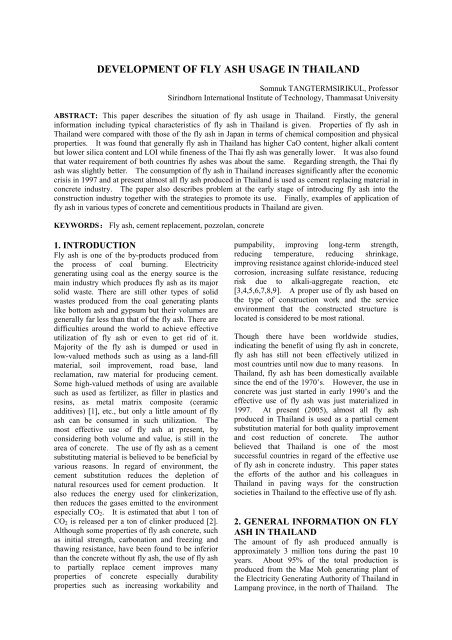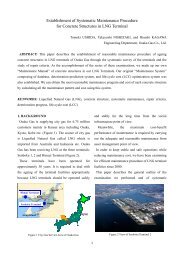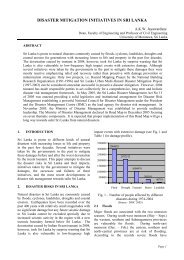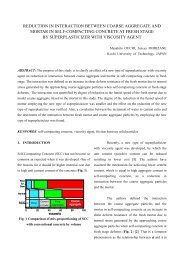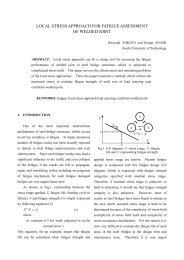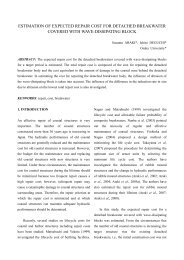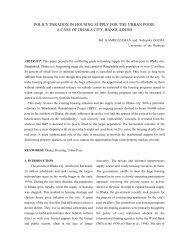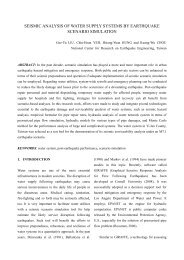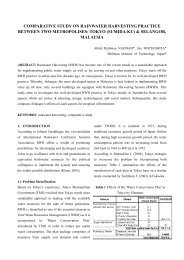DEVELOPMENT OF FLY ASH USAGE IN THAILAND
DEVELOPMENT OF FLY ASH USAGE IN THAILAND
DEVELOPMENT OF FLY ASH USAGE IN THAILAND
You also want an ePaper? Increase the reach of your titles
YUMPU automatically turns print PDFs into web optimized ePapers that Google loves.
<strong>DEVELOPMENT</strong> <strong>OF</strong> <strong>FLY</strong> <strong>ASH</strong> <strong>USAGE</strong> <strong>IN</strong> <strong>THAILAND</strong><br />
Somnuk TANGTERMSIRIKUL, Professor<br />
Sirindhorn International Institute of Technology, Thammasat University<br />
ABSTRACT: This paper describes the situation of fly ash usage in Thailand. Firstly, the general<br />
information including typical characteristics of fly ash in Thailand is given. Properties of fly ash in<br />
Thailand were compared with those of the fly ash in Japan in terms of chemical composition and physical<br />
properties. It was found that generally fly ash in Thailand has higher CaO content, higher alkali content<br />
but lower silica content and LOI while fineness of the Thai fly ash was generally lower. It was also found<br />
that water requirement of both countries fly ashes was about the same. Regarding strength, the Thai fly<br />
ash was slightly better. The consumption of fly ash in Thailand increases significantly after the economic<br />
crisis in 1997 and at present almost all fly ash produced in Thailand is used as cement replacing material in<br />
concrete industry. The paper also describes problem at the early stage of introducing fly ash into the<br />
construction industry together with the strategies to promote its use. Finally, examples of application of<br />
fly ash in various types of concrete and cementitious products in Thailand are given.<br />
KEYWORDS: Fly ash, cement replacement, pozzolan, concrete<br />
1. <strong>IN</strong>TRODUCTION<br />
Fly ash is one of the by-products produced from<br />
the process of coal burning. Electricity<br />
generating using coal as the energy source is the<br />
main industry which produces fly ash as its major<br />
solid waste. There are still other types of solid<br />
wastes produced from the coal generating plants<br />
like bottom ash and gypsum but their volumes are<br />
generally far less than that of the fly ash. There are<br />
difficulties around the world to achieve effective<br />
utilization of fly ash or even to get rid of it.<br />
Majority of the fly ash is dumped or used in<br />
low-valued methods such as using as a land-fill<br />
material, soil improvement, road base, land<br />
reclamation, raw material for producing cement.<br />
Some high-valued methods of using are available<br />
such as used as fertilizer, as filler in plastics and<br />
resins, as metal matrix composite (ceramic<br />
additives) [1], etc., but only a little amount of fly<br />
ash can be consumed in such utilization. The<br />
most effective use of fly ash at present, by<br />
considering both volume and value, is still in the<br />
area of concrete. The use of fly ash as a cement<br />
substituting material is believed to be beneficial by<br />
various reasons. In regard of environment, the<br />
cement substitution reduces the depletion of<br />
natural resources used for cement production. It<br />
also reduces the energy used for clinkerization,<br />
then reduces the gases emitted to the environment<br />
especially CO 2 . It is estimated that abut 1 ton of<br />
CO 2 is released per a ton of clinker produced [2].<br />
Although some properties of fly ash concrete, such<br />
as initial strength, carbonation and freezing and<br />
thawing resistance, have been found to be inferior<br />
than the concrete without fly ash, the use of fly ash<br />
to partially replace cement improves many<br />
properties of concrete especially durability<br />
properties such as increasing workability and<br />
pumpability, improving long-term strength,<br />
reducing temperature, reducing shrinkage,<br />
improving resistance against chloride-induced steel<br />
corrosion, increasing sulfate resistance, reducing<br />
risk due to alkali-aggregate reaction, etc<br />
[3,4,5,6,7,8,9]. A proper use of fly ash based on<br />
the type of construction work and the service<br />
environment that the constructed structure is<br />
located is considered to be most rational.<br />
Though there have been worldwide studies,<br />
indicating the benefit of using fly ash in concrete,<br />
fly ash has still not been effectively utilized in<br />
most countries until now due to many reasons. In<br />
Thailand, fly ash has been domestically available<br />
since the end of the 1970’s. However, the use in<br />
concrete was just started in early 1990’s and the<br />
effective use of fly ash was just materialized in<br />
1997. At present (2005), almost all fly ash<br />
produced in Thailand is used as a partial cement<br />
substitution material for both quality improvement<br />
and cost reduction of concrete. The author<br />
believed that Thailand is one of the most<br />
successful countries in regard of the effective use<br />
of fly ash in concrete industry. This paper states<br />
the efforts of the author and his colleagues in<br />
Thailand in paving ways for the construction<br />
societies in Thailand to the effective use of fly ash.<br />
2. GENERAL <strong>IN</strong>FORMATION ON <strong>FLY</strong><br />
<strong>ASH</strong> <strong>IN</strong> <strong>THAILAND</strong><br />
The amount of fly ash produced annually is<br />
approximately 3 million tons during the past 10<br />
years. About 95% of the total production is<br />
produced from the Mae Moh generating plant of<br />
the Electricity Generating Authority of Thailand in<br />
Lampang province, in the north of Thailand. The
est of fly ashes are produced near Bangkok. In<br />
this section, some comparative studies are<br />
conducted to compare the general trend of<br />
characteristics of fly ash produced in Thailand and<br />
Japan.<br />
2.1 Typical characteristics of fly ash in<br />
Thailand<br />
2.1.1 Chemical Composition<br />
Table 1 compares the ranges of chemical<br />
composition of fly ash in Japan and Thailand.<br />
The data of Thai fly ashes are those observed<br />
continuously for more than 10 years. The data of<br />
Japanese fly ashes, though were obtained from a<br />
single study, covered large enough sample types<br />
and sources i.e. 40 types of fly ash from 24<br />
generating plants in Japan [10]. It can be seen<br />
that the chemical composition of fly ash in<br />
Thailand covers a wider range than that of Japan.<br />
This is mainly because, in addition of the<br />
differences of the types of the plants and processes,<br />
Thailand uses many sources of coal both local and<br />
imported ones. The biggest local source is in<br />
Mae Moh, Lampang province, which is located in<br />
the north of Thailand. The coal used in Mae Moh<br />
is lignite while most of the imported coals are<br />
anthracite or bituminous coals. It is noted that for<br />
the Mae Moh fly ash, which comprises of 95% of<br />
the total fly ash produced in Thailand, the<br />
scattering of the chemical composition is not<br />
much.<br />
From Table 1, most of the Thai fly ashes have<br />
lower SiO 2 content, larger CaO and alkali content<br />
than the Japanese fly ash. Though the data on<br />
SO 3 content of the Japaneses fly ash does not<br />
appear in the Table, it is realized that most of the<br />
Thai fly ashes have rather high SO 3 content. It<br />
must be noted here that the high CaO and high SO 3<br />
fly ash mostly belongs to the Mae Moh power<br />
plant where lignite coal is used.<br />
Table 1 Comparison of Chemical Compostion between Fly Ashes in Japan and Thailand<br />
Composition Japan* (%) Thailand** (%)<br />
SiO 2<br />
CaO<br />
Al 2 O 3<br />
Fe 2 O 3<br />
SO 3<br />
MgO<br />
(Na 2 O+0.658K 2 O)<br />
47-70<br />
0.49-7.55<br />
15.64-32.03<br />
2.54-15.68 (majority
2.2 Properties of Paste, Mortars and Concrete<br />
using Fly Ash<br />
2.2.1 Water Requirement<br />
Table 3 shows the comparison of water<br />
requirement between the Thai fly ashes and the<br />
Japanese fly ashes. It should be noted here that<br />
the test methods of both countries are not the same<br />
(JIS A6201-1991 was used to test the Japanese fly<br />
ashes and ASTM C311 was used to test the Thai<br />
fly ash). Mix proportion of the test samples,<br />
apparatus and the test procedure are all different.<br />
Especially for the mix proportion, in JIS<br />
A6201-1991, the water to binder ratio of the<br />
control sample (cement only mortar) is set at 0.65<br />
and the sand to binder ratio is 2.0 while ASTM<br />
C311 specifies water to binder ratio of 0.484 and<br />
sand to binder ratio of 2.75. However, though<br />
both countries’ fly ashes were tested based on<br />
different standards but they have the same concept<br />
to evaluate the test results. If the two set of data<br />
are compared by discarding the difference of the<br />
test methods, then both countries’ fly ashes have<br />
similar water requirement as can be seen from<br />
Table 3. The lower loss on ignition makes the<br />
Thai fly ashes have similar level of water<br />
requirement to the Japanese fly ashes though they<br />
are coarser.<br />
Table 3 Comparison of Water Requirement between Fly Ashes in Japan and Thailand<br />
Properties Japan* (%) Thailand** (%)<br />
Water requirement (%of<br />
the control)<br />
91-105 (majority
2.3 Fly Ash Consumption in Thailand<br />
Fig.1 shows the fly ash consumption in concrete in<br />
Thailand. The consumption shown in the figure<br />
is only for those used as a cement replacing<br />
material in concrete. In Thailand, up to the time<br />
this report is being written, almost 100% of the fly<br />
ash consumption is for this purpose. It is<br />
expected that the consumption of fly ash in cement<br />
and concrete will still increase in the future.<br />
3000000<br />
2500000<br />
2000000<br />
1500000<br />
1000000<br />
1000000<br />
800000<br />
1400000<br />
1800000<br />
2300000<br />
2700000<br />
500000<br />
0<br />
400000<br />
400 1000 2200 15460<br />
'94 '95 '96 '97 '98 '99 '00 '01 '02 '03 '04<br />
Fly ash consumption (tons)<br />
Fig.1 Fly ash consumption in concrete in Thailand<br />
(The value of year 2000 is the forecasted one)<br />
Fig.2 and Fig.3 show the statistics of fly ash used in<br />
various types of concrete. It can be seen from Fig.2<br />
that up to 1997, fly ash was used mostly to produce<br />
special concrete like self- compacting concrete, sulfate<br />
resisting concrete and low heat concrete for mass<br />
concreting. However, the situation changes in 1999<br />
when fly ash was used mostly in normal concrete.<br />
This expressed that fly ash had become more and<br />
more popular and engineers were more and more<br />
confident with the fly ash application in concrete at<br />
that time. At present, fly ash has already become a<br />
conventional cement replacing material in Thailand so<br />
that majority of the ready-mixed concrete plants,<br />
including those in precast concrete and on-site ready<br />
mixed plants, are using it as a major cementitious<br />
material and fly ash concrete has now become a<br />
conventional concrete in Thailand.<br />
LHC<br />
SRC<br />
4%<br />
SCC<br />
5%<br />
NC<br />
8% Others<br />
1%<br />
SRC<br />
SCC<br />
LHC<br />
82%<br />
NC<br />
Others<br />
Fig.2 Distribution of fly ash used in various types of concrete from 1994-1997<br />
LHC:Low heat concrete, SRC:Sulfate resisting concrete,<br />
SCC:Self compacting concrete, NC:Normal concrete
LHC<br />
NC<br />
46%<br />
Others<br />
12%<br />
SRC<br />
SCC<br />
SCC<br />
2%<br />
SRC<br />
5%<br />
LHC<br />
35%<br />
NC<br />
Others<br />
Fig.3 Distribution of fly ash used in various types of concrete in 1999<br />
(forecasted from January to April 1999)<br />
LHC:Low heat concrete, SRC:Sulfate resisting concrete,<br />
SCC:Self-compacting concrete, NC:Normal concrete<br />
3. PROBLEMS AND STRATEGIES TO<br />
PROMOTE THE USE <strong>OF</strong> <strong>FLY</strong> <strong>ASH</strong><br />
3.1 Problems<br />
During 1980’s, the image of fly ash produced from<br />
Mae Moh was negative due to many researchers’<br />
reports which pointed out the volume instability of<br />
concrete using fly ash due to high SO 3 content in<br />
the fly ash (mostly in the range of higher than 5%<br />
by weight of the fly ash) [12, 13]. Therefore the<br />
uses of fly ash at that time were in the low-value<br />
manners such as used for soil improvement, for<br />
embankment slope stability, for sub-base of<br />
pavement, for concreting of temporally pavement,<br />
etc. It was until the early 1990’s that the SO 3<br />
content of fly ash became lower to conservative<br />
values of below 5%. From that time, various<br />
intensive researches were restarted and many<br />
merits were found from using the fly ash in<br />
concrete as mentioned earlier in the section of<br />
introduction. In spite of the positive study results,<br />
fly ash was very little used in concrete production<br />
until 1997 (see Fig.1) due to many reasons as<br />
follows.<br />
1) Lack of understanding and knowledge on<br />
fly ash among the engineers<br />
2) Doubt on fly ash quality and its<br />
consistency<br />
3) No systematic supplying system to<br />
facilitate the use.<br />
3.2 Strategies<br />
Many efforts were made by the Committee on<br />
Concrete and Materials of the Engineering Institute<br />
of Thailand to promote the use of fly ash in<br />
Thailand.<br />
3.2.1 Research<br />
An original research group consisting of<br />
researchers from 7 universities in Thailand was<br />
formed to study the properties of fly ash and<br />
concrete using fly ash. By this original group,<br />
more than 30 research reports and more than 100<br />
technical papers had been already published until<br />
2000. After that many other universities also<br />
started to conduct research on fly ash and many<br />
more publications have been produced since then.<br />
3.2.2 Education and Training<br />
From 1994 to 2001, eight seminars were arranged,<br />
by the committee, in various places around the<br />
country to give information and educate engineers<br />
on the effective use of fly ash in concrete. A<br />
learn-on-line project was created by the<br />
cooperation between the National Science and<br />
Technology Development Agency, the Electricity<br />
Generating Authority of Thailand and the Joint<br />
Research Group to provide information in a more<br />
effective and broadened way [14]. Many books<br />
and documents were also published for the purpose<br />
of educating engineers in the country [11,15]<br />
3.2.3 Support for Real Practice<br />
Various efforts were made to provide support for<br />
real application as follows<br />
1) Conducting demonstration construction<br />
using fly ash concrete. Many<br />
demonstration construction projects were<br />
conducted during 1992 to 1996 (see Figs.<br />
4, 5 and 6) to provide information.
2) Set up a unit called “By-Product Business<br />
Unit” at the Mae Moh generating plant for<br />
supplying business and quality control of<br />
fly ash. For quality control, the fine coal<br />
used for boiler burning is blended from<br />
various locations and layers of coal mines<br />
in Mae Moh in order to both satisfy the<br />
requirement of energy output and obtain<br />
fly ash with constant properties. At the<br />
moment, the measured properties of fly<br />
ash for quality control at Mae Moh are<br />
CaO, SiO 2 and SO 3 contents. It is<br />
expected that fineness will be another<br />
measured value for quality control at Mae<br />
Moh in the near future. Since fly ash is<br />
not an industrial product but a by-product,<br />
the qualities of fly ash is expected to vary<br />
and be not constant like cement. The<br />
variation in properties is one of the main<br />
hurdles for fly ash using in many parts of<br />
the world, not excepting Thailand. This<br />
system of quality control at the origin<br />
together with the coal blending technique<br />
will help reducing the uncertainty of fly<br />
ash quality and provide confidence to the<br />
users.<br />
3) Provision of standard for fly ash. One of<br />
the problems at the beginning of fly ash<br />
application is the lack of appropriate<br />
standard that suited the local fly ash.<br />
According to many foreign standards, the<br />
properties of Thai fly ash especially the<br />
Mae Moh fly ash did not pass the<br />
requirement on fineness. However,<br />
researches had proved that though the fly<br />
ash had low fineness, it provided very<br />
satisfactory performance when used in<br />
concrete. Many performances are even<br />
better than fly ashes from many other<br />
countries. The committee on concrete<br />
and materials of the Engineering Institute<br />
of Thailand then decided to draft a new<br />
standard specification for fly ash in<br />
Thailand based on properties of Thai fly<br />
ashes and was published in 2003 [16].<br />
Tables 5, 6 and 7 summarize the classes of<br />
fly ash and the corresponding chemical<br />
and physical requirements according to<br />
the latest Thai specification.<br />
4) Produced references for practical<br />
engineers. Two books were published<br />
for being used as references for practical<br />
engineers [11,15].<br />
5) A software “FACOMP T1.0” was<br />
developed as a tool to facilitate the<br />
practical engineers for mix proportioning<br />
of fly ash concrete (see Fig.7).<br />
6) Encouraged ready-mixed concrete<br />
company to launch special fly ash<br />
concrete products such as marine concrete,<br />
sulfate-resisting concrete, sulfate-resisting<br />
concrete, self-compacting concrete,<br />
low-heat concrete, etc.<br />
Item<br />
Properties<br />
Table 5 Chemical properties<br />
First class<br />
Type a<br />
Requirement<br />
Second class<br />
Type b<br />
Third class<br />
1 Silicon dioxide (SiO 2 ), min. % 30.0 30.0 30.0 30.0<br />
2 Calcium oxide (CaO), % - Less than 10.0<br />
Not less than<br />
10.0<br />
-<br />
3 Sulfur trioxide (SO 3 ), max. % 5.0 5.0 5.0 5.0<br />
4 Moisture content, max. % 3.0 3.0 2.0 3.0<br />
5 LOI content, max. % 6.0 1) 6.0 1) 6.0 1) 12.0<br />
Note: 1) The use of fly ash with up to 12% LOI may be approved if either acceptable performance records or<br />
laboratory test results are made available.
Table 6 Chemical properties (optional)<br />
Requirement<br />
Item<br />
Properties<br />
First class<br />
Second class<br />
Type a Type b<br />
Third class<br />
1<br />
Alkali content (Na 2 O + 0.658K 2 O) 1) , max. %<br />
1.1 when SO 3 between 3.0 to 5.0 %<br />
1.2 when SO 3 less than 3.0 %<br />
1.5<br />
4.0<br />
1.5<br />
4.0<br />
1.5<br />
4.0<br />
1.5<br />
4.0<br />
Note: 1) Fly ash with alkali content exceeding this limitation may be approved if the test results on control of<br />
alkali-silica reaction satisfy the requirement.<br />
Table 7 Physical properties<br />
Item Properties First<br />
Requirement<br />
Second class<br />
class Type a Type b<br />
Third class<br />
1<br />
Fineness (select a method)<br />
Amount retained on 45-μm-mesh sieve, max. %<br />
Or Blaine fineness, min. cm 2 /g<br />
10<br />
6000<br />
50<br />
2300<br />
55<br />
2000<br />
65<br />
1600<br />
2<br />
Strength activity index 1) with OPC type 1<br />
7-day, min. % of the control<br />
85<br />
28-day, min. % of the control<br />
95<br />
91-day, min. % of the control 2) 100<br />
70<br />
75<br />
85<br />
70<br />
75<br />
85<br />
60<br />
70<br />
75<br />
3 Water requirement, max. % of the control 102 105 105 108<br />
4 Autoclave expansion 3) , max. % 0.8 0.8 0.8 0.8<br />
Fig.4 Demonstration of mass concreting using fly ash concrete at Mae Moh power generating plant
Fig.5a Concrete wall<br />
Fig.5b Concrete box culvert<br />
Fig.5 Demonstration of Self-Compacting Concrete using fly ash at Mae Moh power generating plant<br />
Fig.6 Demonstration construction of Roller-Compacted Concrete Pavement using fly ash at Mae Moh<br />
power generating plant
Fig.7 A computer software for mix proportioning of fly ash concrete<br />
4. APPLICATION <strong>OF</strong> <strong>FLY</strong> <strong>ASH</strong> <strong>IN</strong><br />
CONCRETE<br />
Fly ash has become a popular cement replacing<br />
materials for concrete application since 1997 (see<br />
Fig.1) after the country faced economic crisis.<br />
One of the main reasons is that the cost of fly ash<br />
is much lower than that of the cement. The<br />
immediate gain from the low cost of fly ash could<br />
overcome the more<br />
4.1 Ready-Mixed Concrete<br />
For ready-mixed concrete, fly ash is normally used<br />
to replace cement in the ranges of 20 to 30% by<br />
weight of the total cementitious materials. Fly<br />
ash concrete has become conventional concrete for<br />
ready-mixed concrete industry. As mentioned<br />
above, many ready-mixed concrete companies<br />
started to launch special concrete products with fly<br />
ash such as marine concrete, sulfate-resisting<br />
concrete, sulfate-resisting concrete,<br />
self-compacting concrete, low-heat concrete, since<br />
late 1990’s. Some high volume fly ash concrete<br />
were also practiced in Thailand with the maximum<br />
fly ash content up to 55% of the total binders for<br />
self-compacting concrete, 47.5% for low-heat<br />
concrete and 68% for roller-compacted concrete<br />
(see Fig.8 for Pak Mool dam constructed using<br />
roller-compacted concrete). The ready-mixed<br />
concrete industry is currently the major consumer<br />
of fly ash in Thailand.<br />
Fig.8 Pak Mool dam in Ubol Rachathani constructed using roller-compacted concrete with fly ash content<br />
of 68% of the total cementitious materials.
4.2 Precast Concrete, Concrete Products<br />
For precast concrete and concrete product<br />
industries, fly ash is normally used in the works<br />
that does not require early strength such as<br />
non-prestressed concrete works. For prestressed<br />
concrete industries, fly ash is also used but with a<br />
maximum cement replacement of only up to 10%.<br />
The exception may be in the case of<br />
self-compacting concrete application in which fly<br />
ash may be used up to a range of 30% to 50% even<br />
in prestressed concrete work..<br />
4.3 Other Cementitious Products<br />
Some cementitious material products which use fly<br />
ash to replace cement in the production are such as<br />
cementitious fibered roof tile, cementitious fibered<br />
panel, etc. In this category, fly ash is normally<br />
used up to a maximum of 30% of the total<br />
cementitious materials.<br />
4.4 Blended Cement<br />
Some cement companies have made efforts to<br />
introduce ready-blended fly ash cement into the<br />
concrete market in Thailand. Most of them are<br />
introduced in the form of cement for durability<br />
purposes such as cement for marine environment<br />
having high resistance against sulfate attack and<br />
chloride-induced steel corrosion, sulfate-resisting<br />
cement or low-heat cement, etc. However, these<br />
cements are still not popular especially for project<br />
constructions using ready-mixed concrete. For<br />
projects, where ready-mixed concrete is usually<br />
applied, it is more popular to mix fly ash at the<br />
ready-mixed concrete plants. This is because 1)<br />
ready-blended fly ash cement is more expensive<br />
than cement with fly ash as a separate binder, 2)<br />
the ratio of fly ash is usually adjusted according to<br />
the required performances of concrete when it is<br />
used as a separate binder.<br />
4.5 Repair Materials<br />
Fly ash is also used in enhancing performances and<br />
reducing cost of some repair materials especially<br />
for grouting materials. Fly ash has also been<br />
studied as a stabilizer and to control expansion of<br />
expansive cement [17].<br />
5. CONCLUD<strong>IN</strong>G REMARKS<br />
Based on what mentioned in this paper, it can be<br />
said that Thailand has become a very successful<br />
country in regard of fly ash usage in concrete<br />
industry. The success was obtained on great<br />
efforts and good strategic planning and patience of<br />
a number of academicians and professional<br />
engineers. The use of fly ash has also become<br />
one of the significant factors to change the concept<br />
of concrete practice in Thailand from that<br />
considering strength only to considering both<br />
strength and durability.<br />
REFERENCES<br />
1. Huang, J.Y., Beneficial Use of Fly Ash, Michigan<br />
Technological University<br />
2. Sisomphon, K., Hongvinitkul, S.,<br />
Nimityongskul, P., Tangtemsirikul, S. and<br />
Rachdawong, P., Uses of Municipal Solid<br />
Waste Ash as Construction Materials,<br />
Proceedings of the 7th East Asia-Pacific<br />
Conference on Structural Engineering &<br />
Construction, 27-29 August 1999, Kochi<br />
University of Technology, Kochi, Japan, pp.<br />
1366-1371<br />
3. Tangtermsirikul, S., Sudsangium, T. and<br />
Nimityongsakul, P., Class C Fly Ash as a<br />
Shrinkage Reducer for Cement Paste,<br />
Proceedings of the 5th CANMET/ACI<br />
International Conference on Fly Ash, Silica<br />
Fume, Slag and Natural Pozzolans in<br />
Concrete, 4-9 June 1995, Milwaukee,<br />
Wiscosin, USA, Vol.1, pp.385-401<br />
4. Tangtermsirikul, S. and Chatveera, B.,<br />
Development of Low Heat Concrete using<br />
Lignite Fly Ash, Proceedings of the 4th<br />
International Conference on Civil<br />
Engineering, 6-8 November 1996, Manila,<br />
Philippines, pp.786-795<br />
5. Tangtermsirikul, S. and Chatveera, B.,<br />
Expansion of Cement Paste and Mortar using<br />
Lignite Fly Ash, Supplementary Papers of the<br />
3rd CANMET/ACI International Symposium<br />
on Advances in Concrete Technology, 24-27<br />
August 1997, Auckland, New Zealand, pp.<br />
321-329<br />
6. Tangtermsirikul, S., Kaewkhluab, T. and<br />
Jitvutikrai, P., A compressive strength model<br />
for roller-compacted concrete with fly ash,<br />
Magazine of Concrete Research, Vol.56, No.1,<br />
February 2004, pp. 35-44<br />
7. Samranwanich, T. and Tangtermsirikul, S., A<br />
Model for Predicting Time Dependent<br />
Chloride Binding Capacity of Cement-Fly<br />
Ash Binder System, Materials and Structures,<br />
RILEM, Vol.37, No.270, July 2004,<br />
pp.387-396<br />
8. Krammart, P and Tangtemsirikul, S.,<br />
Expansion, Strength Reduction and Weight<br />
Loss of Fly Ash Concrete in Sulfate Solution,<br />
ASEAN Journal on Science and Technology<br />
for Development, Vol.21, Issue 4, December<br />
2004, pp.373-390<br />
9. Khunthongkeaw, J. and Tangtermsirikul, S.,<br />
Model for Simulating Carbonation of Fly Ash<br />
Concrete, The 1 st International Conference of<br />
Asian Concrete Federation, Chiang Mai,<br />
Thailand, 28-29 October 2004, pp. 907-917<br />
10. Yamamoto, T. and Kanazu, T., Accelerated<br />
Chemic al Assessing Method for Pozzolanic
Activity of Fly Ash, Abiko Research<br />
Laboratory Report No. U98047, Central<br />
Research Institute of Power Industry, Japan<br />
11. Tangtermsirikul, S., Mix Design of Fly Ash<br />
Concrete (in Thai), Engineering Institute of<br />
Thailand, November 1999, ISBN<br />
974-382-909-9<br />
12. Ashino, M., Mix Design of Fly Ash Cement<br />
Concrete using Mae Moh Fly Ash, M. Eng.<br />
Thesis No. ST-84-1, Asian Institute of<br />
Technology, April 1984<br />
13. Chindapresert, P. and Horvichit, I., Properties<br />
of Portland Cement mixed with Mae Moh Fly<br />
Ash, Office of Technology for Rural<br />
Development, Faculty of Engineering, Khon<br />
Kaen University, 1985<br />
14. http://flyash.learn.in.th<br />
15. Committee on Concrete and Materials of<br />
Engineering Institute of Thailand, Use of Fly<br />
Ash in Concrete, October 2001, ISBN<br />
974-7197-28-6<br />
16. Committee on Concrete and Materials of<br />
Engineering Institute of Thailand, Standard<br />
Specification for Materials and Construction of<br />
Concrete Structures, 1 st revision, 2003, ISBN<br />
974-91685-4-2<br />
17. Jakpisal, V. and Limsuwan, E., Development of<br />
Shrinkage-Compensating Cement, Proceedings<br />
of the 1 st National Concrete Convention,<br />
Kanchanaburi, 14-16 May 2003, pp.23-27


